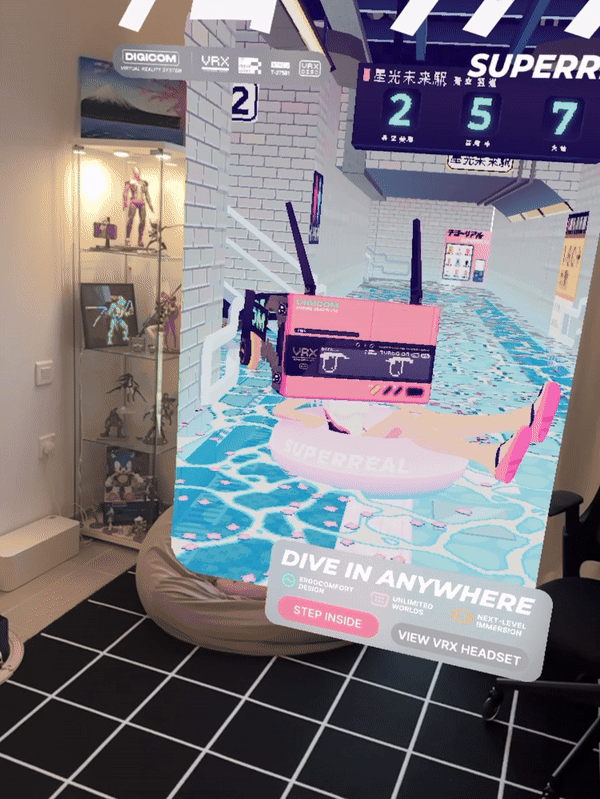The Future of 3D Design: An Interview with Bezi's Co-Founder Cecilia Uhr
We’re starting to see this happen with AI and other emerging technologies—as new technologies develop, so will the need for tools that enable designers to create and ideate with them. Bezi is one of those tools for 3D and spatial design. A platform that allows designers and their collaborators to prototype on a spatial canvas together, Bezi offers a much-needed bridge between the future of VR products and the day-to-day workflow tools that designers need to actually build those products and services.
We recently sat down (virtually, in 2D) with Bezi's Co-founder and Founding Designer Cecilia Uhr to learn more about her biggest lessons as a founder, why designers should consider joining a company building tools for other designers, and what’s next for the future of 3D and spatial design.
Briefly, what does Bezi do?
Bezi enables designers to create and prototype interactive, 3D, and spatial experiences in a no-code environment. We offer an intuitive experience that makes it easy for designers to onboard and start creating in minutes.
Our primary users are professionals in the design industry who need to collaborate and ideate in 3D. They might be developing VR experiences, for example, and need a tool that can easily integrate into their daily workflows. We’re also seeing a ton of excitement coming from students and different universities where professors are starting to teach spatial design. These students grew up with 3D technology, so for them it seems like a natural progression of the industry. They’re looking for a design tool they can pick up easily, and one that enables them to explore ideas without as much friction as other 3D tools.
Why was it important to create a spatial design tool specifically for designers?
In terms of 2D, it seems like there been new tools that pop up every day—new video editing tools or new Photoshop-adjacent platforms like Figma. But the 3D industry really hasn't been revolutionized in a long time. Some of the other existing platforms have been around for decades, dating back to the ‘80s or ‘90s. Yet our expectations for design tools have changed so much since that time.
Bezi is created specifically for designers. We talked to hundreds of designers during our discovery phase, and the thing we heard over and over was that designers don’t want to have to learn a game engine like Unity just to explore ideas. With Bezi, we borrow some patterns from design tools that designers are already familiar with to make onboarding faster and more intuitive. Our users tell us that Bezi allows them to do things they weren’t able to do before, which is designing and prototyping in 3D without knowing how to code.
What have you learned about designing for designers?
Designing a design tool is a very meta thing, and designing for designers is a unique challenge. Being a designer myself, I know how difficult we are as customers. We have such a high bar for quality.
If you’re designing a product for designers, you need to have a designer on the founding team—I think it would be very difficult for a company not have a designer founder on the team and try to build a design tool.Cecilia Uhr

How have you seen design be a differentiator for Bezi?
Design is critical to our success because regardless of how many features we might have, if the product flow doesn’t make sense or has a lot of friction, people will eventually look for something else that better solves their problem. There’s a huge opportunity for us to come up with intuitive and more modern design patterns, and some of that’s reflected in our brand and marketing. We want Bezi to feel super accessible, modern, and fun to use.
That’s actually a big part of it—for a design tool to be incorporated into your workflow, it needs to feel fun to use. I don’t mean that it needs to be gamified. Fun is when something’s delightful and you’re able to achieve your desired outcome quickly. That’s exactly what we enable. You could spend days using a game engine to design an experience or do the same thing within 30 minutes to an hour with Bezi—that’s what makes it fun. We try to embody that both in our product and our brand.
 Design is critical to our success because regardless of how many features we might have. If the product flow doesn’t make sense or has a lot of friction, people will eventually look for something else that better solves their problem.Cecilia Uhr, Co-founder of Bezi
Design is critical to our success because regardless of how many features we might have. If the product flow doesn’t make sense or has a lot of friction, people will eventually look for something else that better solves their problem.Cecilia Uhr, Co-founder of Bezi
Why is it important for Bezi to be easy to use?
The accessibility of new tools is what moves the industry forward. One of our missions at Bezi is we want more people to be able to design in 3D. A lot of people are interested in the technology, but the biggest barrier to entry is needing to code in order to make anything interactive.
We built Bezi as a web-based tool because we want it to be as accessible as possible. As long as you have connection to internet, regardless of what kind of device you're on—whether it's desktop, mobile, or headset—you're able to get into Bezi and just start creating.

How did you develop the idea for Bezi?
Originally, I came from a design agency background where I was doing branding, packaging design, and website design. When an opportunity came up to work at Oculus, I didn’t know anything about VR or 3D but I jumped at the chance. I faced a huge learning curve when trying to learn tools like Unity. The biggest barrier was that they weren’t really created for me—a designer—and that’s when we realized there was a huge problem and opportunity.
Joining a big company like Meta that has a lot of resources, I expected there to be a whole host of tools available to get my job done, and I was pretty shocked when that wasn’t the case. I would hodgepodge different tools together but that wasn’t ideal, either. For example I would try to explain 3D concepts using 2D tool like Figma, which led to a lot of miscommunication.
Later, when I moved to a different role and was working with a lot of different designers horizontally across the organization, I realized that I wasn’t the only one who had this problem. There were some efforts internally to create tools and solutions, but they often solved very specific problems instead of tackling the issue from a holistic design flow perspective. That’s when Julian Park, Denys Bastov, and I came together around the idea of building a tool that would solve all of these problems.
What does the Bezi design team look like?
We’re a pretty small team right now. Out of ten people total, we have two designers including myself. We’re hiring for a few open roles, however! It’s important for us to find people who are really aligned with our mission and are passionate about the future that we envision together.
Fundraising has been a big focus for you as a designer founder. Do you have any advice for founders getting ready for their own raise?
One of the most important things for fundraising as an early stage startup is storytelling. You’re going to be the industry expert in the room, so it’s your job to paint the picture about what problem you’re solving, and how the world will change through your company. As designers, I think we have a unique advantage when it comes to storytelling with empathy. I would encourage designer founders to lean into that and just keep honing in your pitch.
Another thing that I think founders should be more transparent about is how tough the fundraising process can be. During our fundraise, we talked to a lot of other founders and everyone had similar stories. Fundraising is hard, and you need to go into the process with the mindset that it will take time. But you’ll get there. Don’t get discouraged by people who say no because there’s a million reasons that might not necessarily be related to you, your company, or what you’re doing. Rejection in any form stings, but just keep believing in your vision and be confident every time you go into a new meeting. You just need one person to say believe in you and say yes.
What else have you learned about building a design-driven company?
From day one of your company, you need to get people caring about design. It needs to be a part of the culture and the DNA of the company from the very beginning, because that will help you scale and grow. I do think the easiest and best way to do this is have a designer be a part of the founding team. That way, you just have person who embodies those values and is able to amplify that across the team.
For Bezi, that’s been really organic because Julian and Denys are engineers who already care a lot about design. For example, Denys is a great photographer and also writes and directs film on the side. They’re both very in tune with the creative side of things.
What are some of the rituals that help nurture design culture at Bezi?
One thing we do is have design crit every week. Everyone from the team is invited and we go through the design of a feature we’re working on and we talk about it together. We cover things like the persona we're building for, insights from competitive audits, why something works, or why something doesn't work. All of these discussions are had as a team, so that the knowledge is shared.
This might have to evolve as we scale, but it’s worked well for us because it puts everyone on the same page and sets the bar for the quality and care that goes into every design. Creating open and honest spaces for these conversations really helps drive that culture as a team.
Another thing we’re focused on is our user personas. We go really deep into trying to figure out who they are, what they’re doing on a daily basis, what their design workflows look like, what the pain points there are, and what their goals are. We want Bezi to solve real problems for people, and with a design tool used by people for their jobs, understanding who our customers are across the company is something that needs to be really dialed in.

How does Bezi balance quality with needing to move quickly?
It’s tough at a small startup to balance craft with shipping quickly. You can’t just focus on one or the other—you need both, especially when you’re building something for designers. On one hand, you want to make sure that everything you put out has a high level of craft and is super polished. On the other, you have a million things that you need to ship and get out the door so that people can start using the product.
Where your balance lies depends on the stage of the company. In our early days, we opted for a faster rollout. We were experimenting quickly and didn’t prioritize the polish as much because we were just trying to get a signal on where we needed to build more. Now that we have a pretty good signal of what people are looking for, we're more cognizant of not breaking things. We’re more focused on polishing existing features so they’re super smooth, buttery to use, and really beautiful. It’s not necessarily us moving slower, it’s about ensuring we’re providing the experience that people expect from a designer-focused product like this.
Any tips for finding that balance personally, as a designer?
If you're creating things that are kind of useless but beautiful, that’s just art. It's not design, in my opinion. Having a period of time where you’re okay with not making things perfect in the beginning is really important.
As designers, we're sometimes tempted to really perfect things down to a micro level. In the beginning of the company, it was a constant struggle for me. Things wouldn’t be at the level I wanted them to be, but I had to be okay with shipping them. That’s why you're in beta for a while, right? It sets expectations with your users that this is a work in progress, and that it will evolve and improve over time.
If you're creating things that are kind of useless but beautiful, that’s just art. It's not design, in my opinion.Cecilia Uhr
Looking to the future, how do you see Bezi pushing the boundaries of spatial design innovation?
I really believe that giving people more access to more powerful tools that are easy to use is going to push the boundaries. The more people you have working in this space and experimenting with ideas, the faster the industry is going to be able to mature.
I think the future of 3D design is going to explode. Previously it's been limited to things like physical objects, industrial design, architecture, 3D art and illustrations, or even interactive game design that’s largely contained within 2D screens. The future that we believe in at Bezi is one where 3D is integrated into the world around you. We’ve seen so many proof points of that starting to happen. Apple Vision Pro is going to be coming out next year, and there are a bunch of big tech companies investing heavily into the space. When that happens, it creates competition which accelerates change and innovation.
I see optimism in this space as well. I see a lot of excitement coming from students and younger professionals. They’ve seen the future, and know what’s possible. It’s just a matter of time for it to really explode.

How are you approaching intersections other emerging technologies, like AI?
AI text-to-image generation has taken such a huge leap in the last year. It’s insane. AI in the realm of 3D is not as advanced because it’s a lot more complex, but we’ve still seen significant improvement over the last six months. We’re looking and waiting for this inflection point to happen in terms of the quality of 3D models you can generate—and we think it’s getting pretty close.
Is there anything else you can share about the future of Bezi, and what we can expect to see from you next?
There are a lot of exciting things I can’t talk about just yet. But what I can say is that we’re going to keep building more advanced features that people have been asking for that will help them build more interactive prototypes. That will continue to be a key focus for us.
